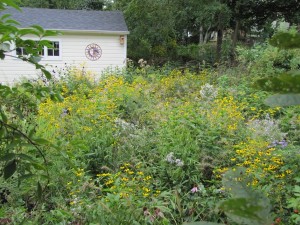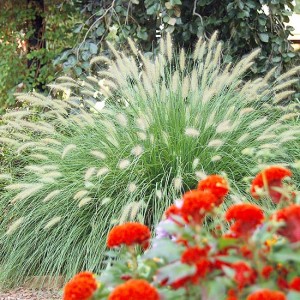What I mean by this is I can do (just about) anything with native plants that can be done with exotic species of plants. The reasons to use natives is ecologically clear. See the Native Plants page on this website for a short explanation why. If you want a longer read, there are many good resources out there. One I highly recommend is Doug Tallamy’s book, Bringing Nature Home.
That’s only half the story, however. I could put a tall grass prairie in my front yard and get significant ecological benefits, but it would look out of place. Some might even say weedy looking. Prairie gardens have a place, but probably not in the front yard. Here is a picture of a backyard prairie garden.
Most people want to accomplish more with their native plant gardens than just create habitat. They want it to look beautiful too. And this is where the title of this post comes in. I can do almost anything with a native planting that you can do with a planting of exotic species (and in some instances more).
For example, Fountain Grass (Pennisetum alopecuroides) is a beautiful common ornamental grass used in landscapes, but its native range is from Eastern Asia to Western Australia. Instead, we can use either Little Bluestem (Schizachyrium scoparium) or Prairie Dropseed (Sporobolus heterolepis), both beautiful natives about the same size and with the similar effects.
Another common landscape grass that is not native is Maidengrass (Miscanthus sinensis) which is native to Eastern Asia and is becoming invasive in the US. A slam dunk native alternative is Swithgrass (Panicum virgatum).
The same kind of native for non-native substitutions hold for wildflowers. There are many examples I can share, but one common non-native landscaping plant is Daylily. Watch this species on a summer day and you will see ZERO pollinators on it. Yellow Daylilies can be replaced by Orange Coneflower (Rudbeckia fulgida), that look much like Black Eyed Susans, but are much longer lived. Orange Coneflower will bloom for a much longer time that Daylilies.
The same kind of native for non-native substitutions can go for bushes, trees, vines, and ferns. The point is that there are native substitutes for common exotic landscaping species that are similar is size, shape, and look but provide much better habitat. This is what I mean by, “Anything You Can Do, I Can Do Better.” A good reference for native substitutes for invasive species is the book, Burrell, C. C., Native Alternatives to Invasive Plants, New York: Brooklyn Botanic Garden, 2007.
The only reason we are unaware of these native substitutes is because of the entrenched interests of big horticulture that promote exotic species and are more willing to spend resources on breeding minor variations of exotic species than promoting the benefits and beauty of natives.
If you want more information on particular substitutes for specific exotics feel free to contact me. I can usually come up with something.










